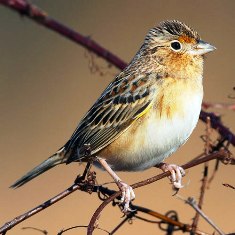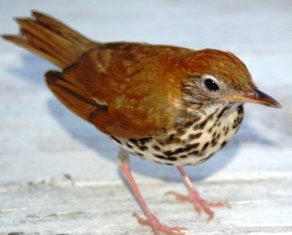Florida's songbirds
Spring is in the air and the Florida birds are all chirping about the great weather. From the time I wake up until I close my eyes at the end of the evening, I can always hear a variety of birds in my back yard. Although they don't always get along with each, I appreciate each and every one of them for their beauty, musical notes, and for making my backyard a lot more interesting. Florida grasshopper sparrows are small, short-tailed birds, about 5
inches long and weighing less than one ounce. This not so drab sparrow
is mostly black and gray with some brown streaks on the back.
Underneath, it is light gray or buff color with no streaking. Feathers
at the bend of the wing are bright yellow and there is an orange patch
in front of the eyes. A white stripe marks the top of the head. The
male’s primary song is weak and grasshopper-like, giving rise to the
bird’s common name.
Like most Floridian backyards we have some Florida scrub jays, with one dominant male that visits my bird bath almost every afternoon. The Florida scrub-jay is a 12-inch-long, blue and gray crestless jay that lacks the white wing spots and tail feather tips of the more common and widespread blue jay. A necklace of blue feathers separates the whiter throat from the gray whitish forehead. The tail is long and loose in appearance, and the back is gray.
The song of the wood thrush is so beautiful it inspired Handel to write a piece of music in the bird's honor. There is no more lovely a sound than the loud, flute-like song, ending in a trill, of this songbird. The wood thrush is large and plump, reddish-brown above and whitish below, with large dark spots on its throat, breast and sides. It has a bold, white eye ring and its tail is short. It is often tied to shade-grown coffee plantations in South America for winter survival, since it requires shady areas. Spring brings it returning to North America to breed in moist deciduous forests.
Like most Floridian backyards we have some Florida scrub jays, with one dominant male that visits my bird bath almost every afternoon. The Florida scrub-jay is a 12-inch-long, blue and gray crestless jay that lacks the white wing spots and tail feather tips of the more common and widespread blue jay. A necklace of blue feathers separates the whiter throat from the gray whitish forehead. The tail is long and loose in appearance, and the back is gray.
The song of the wood thrush is so beautiful it inspired Handel to write a piece of music in the bird's honor. There is no more lovely a sound than the loud, flute-like song, ending in a trill, of this songbird. The wood thrush is large and plump, reddish-brown above and whitish below, with large dark spots on its throat, breast and sides. It has a bold, white eye ring and its tail is short. It is often tied to shade-grown coffee plantations in South America for winter survival, since it requires shady areas. Spring brings it returning to North America to breed in moist deciduous forests.




Comments
Post a Comment